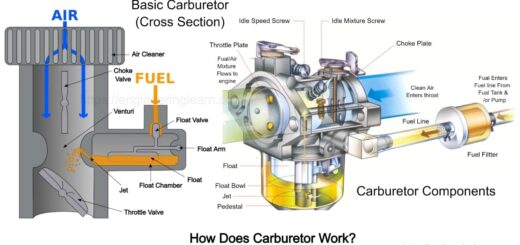CVT Transmission Problems in Car – [Complete Details]
![CVT Transmission Problems in Car - [Complete Details]](https://engineeringlearn.com/wp-content/uploads/2023/03/CVT-Transmission-Problems-1024x539.jpg)
Introduction
CVT Transmission Problems in Car – [Complete Details]: – At the point when there is a catastrophic failure, you can never again drive with a bad CVT transmission. At times, your car will enter limp mode which empowers you to reach a safe place to park or get back. A bad CVT will initially start releasing unusual sounds and actions, for example, juddering, lurching, and so on. Individuals who have lived through a CVT nightmare can figure out why, however then again, there are in a real sense a large number of individuals who drive all over with CVT gearboxes while never having any issues. Furthermore, not just with new cars, but with high mileage cars also.
For instance, there were 100s of individuals (predominantly on gatherings) claiming that their CVT transmissions easily lasted 300,000 kilometers (200,000 miles) and you additionally found forum threads and lawsuits of individuals that experienced total CVT failures before their cars reached 50,000 kilometers (30,000 miles).
CVT Transmission Problems and Failures
With regards to CVT transmission problems and failures, the problem or issue is that a large number of them can’t be directly explained. Certain symptoms can demonstrate multiple problems.
Below are a few significant points which briefly examine CVT transmission problems and failures, however, remember that every one of these problems needs proficient diagnostics.
1. Slipping, Grinding, and Jerking: ( CVT Transmission Problems )
Assuming you feel that your CVT transmission is slipping, you are all in all correct to make a move in diagnosing what the issue is. Excessive slipping of the transmission could demonstrate serious structural transmission issues or problems with the transmission fluid. In the event that there isn’t sufficient transmission fluid, there may be an absence of lubricant that is required for the consistent adjustment of the CVT pulleys and belt or chain. The equivalent could happen assuming the transmission fluid is exhausted. While some slipping of the CVT transmission is typical, you will feel when there is excessive transmission slipping that bothers your customary driving routine.
CVT transmission grinding noises remain a mystery, there is no conclusive response with respect to what the problem is the point at which you hear grinding coming from a CVT transmission. For example, a Honda dealership let us know that any sort of grinding in the CVT gearbox is an indication of broken down internal parts. The grinding noises may be resolved or settled with a more limited transmission fluid interval, yet as a rule, this occurs on high-mileage vehicles where a transmission replacement is expected.
Any sort of CVT transmission jerking, lurching, or bouncing forward is a serious sign of concern. Generally speaking, there are problems with either too low transmission fluid, contaminated, or worn-out transmission fluid or a reinventing of the CVT is required. There are certain accounts where certain CVTs are not just smooth as others and a degree of jerking seems to be normal when the CVT shifts between the “high” and “low” “gears”. There are many individuals online and at dealerships claiming that a level or degree of jerking under low speeds is normal.
2. Whining, Clunking, and Rattling Sounds While Driving: ( CVT Transmission Problems )
Any kind of weird noises coming from the CVT transmission is a sign of trouble. At times, it may very well be that you utilized some wrong transmission liquid or that you want to replace your transmission liquid. Notwithstanding, a lot of CVTs that are making bizarre noises are having trouble with one of the internal bearings.
A decent mechanic will initially preclude other likely sources of bizarre sounds like bad wheel bearings, suspension issues, and braking system problems. Those are a lot less expensive to repair and effectively confused with transmission issues or problems.
3. Control Module Problems: ( CVT Transmission Problems )
Very much like other automatic transmissions, the CVT accompanies a TCM, a transmission control module. This module gathers every kind of signal from different sensors in your car and decides how the transmission ought to respond.
In the event that there is a fault in the transmission control module of your CVT transmission, you might encounter unexpected changes in your transmission behavior. There may be deferred engagement, overstated slipping off the gearbox, and a wide range of different symptoms. You can decide whether the part to blame is your transmission control module when these symptoms show up unexpectedly and without earlier problems. Structural and mechanical damage to the CVT will emerge step by step however electronic problems will generally show up in a flash.
4. Overheating Problems: ( CVT Transmission Problems )
A wide range of automatic transmissions is incredibly sensitive or delicate to overheating. The CVT transmission is no exemption. Overheating can be a consequence of inappropriate, it can happen when there isn’t sufficient transmission fluid or on the other hand in the event that the transmission fluid is worn-out. It can likewise happen in the event that the circulation of the transmission fluid is hindered because of a broken oil pump.
Your car’s dashboard ought to caution you on the off chance that the CVT gearbox is overheating. On the off chance that this occurs, ensure you stop your vehicle straight away. On the off chance that overheating is brought about by traffic conditions (outrageous intensity and delayed unpredictable traffic can overheat the CVT), you can drive away when your CVT gearbox has cooled off. In the event that the overheating transmission warning or cautioning message ignites repetitively, something isn’t quite right about the CVT transmission. Assuming that is the situation, the car ought to go directly to the service center.
5. Transmission Fluid Problems: ( CVT Transmission Problems )
Old and worn-out transmission fluid is the main enemy of CVT transmissions. The greater part of the CVT problems and symptoms are brought about by having a subpar degree of CVT transmission fluid, worn out CVT transmission fluid or wrong CVT transmission liquid. Very much like in any sort of transmission, a sound and adequate measure of transmission fluid forestall mechanical damage of the transmission by lubricating every one of the moving parts and keeping them cool simultaneously.
Ensure your CVT transmission is routinely checked for any leaks and that your CVT transmission fluid is being replaced or supplanted by the manufacturer’s interval. Numerous owners choose to shorten the transmission fluid interval since it has shown extraordinary potential in keeping your CVT better and healthier over the long haul.
6. Slipping Off the Metallic Multi-plate Chain or Belt: ( CVT Transmission Problems )
The metallic multi-plate chain or belt should be clamped down with a specific degree of force to forestall slipping on the pulleys regulating the gear ratio. While a specific measure of slip is alright and expected out of the manufacturing plant, having an excess of slip is an indicator of serious transmission damage.
7. Check Engine Warning Light because of CVT Gearbox Problems: ( CVT Transmission Problems )
Certain CVT-equipped vehicles will accompany a specific “Really look at CVT transmission” warning light on the dashboard message. Most of the time, notwithstanding, the “check engine” warning light will come up, and solely after legitimate diagnostics have been executed will you realize that the fault lies in the internals of the CVT transmission. Some CVT gearboxes will likewise flash one or all of the gear selector lever lights to indicate transmission problems.
8. Flywheel Problems: ( CVT Transmission Problems )
CVT transmission either has a flywheel or a torque converter, like the one you would see on a standard hydraulic automatic transmission. There have been several accounts of flywheel problems on CVT transmissions where the dealership proposed the car proprietors essentially replace the whole CVT gearbox without focusing on the flywheel of the CVT transmission. Some symptoms of a faulty or broken CVT flywheel can vary, there can be slipping, juddering and different issues, however, there are generally no faulty codes while utilizing diagnostic tools which as a rule persuades the dealership to think there is a structural problem with the CVT transmission and that a replacement is needed or required.
Conclusion
CVT transmissions are unquestionably sensitive with regard to maintenance, which essentially includes replacing the transmission fluid and filters. Modern CVT transmissions are certainly reliable. It is difficult to discuss CVT transmissions overall in light of the fact that, we immediately discovered that different CVT transmission makers offer various answers for certain innate CVT faults. And keeping in mind that a CVT transmission from company A can be flawless, the second CVT from organization B can have a similar precise design guideline. However, it actually causes a large number of problems.
Content Source: – lifeonfour
Image Source: – dubizzle













